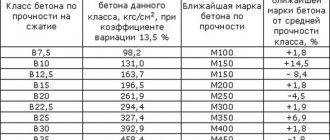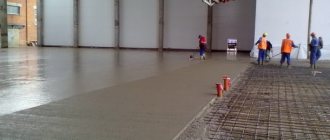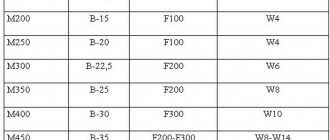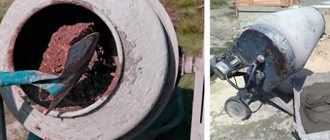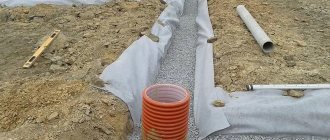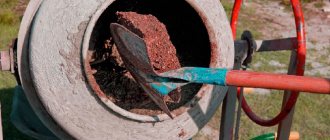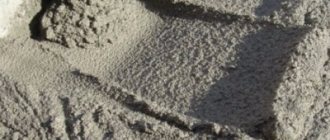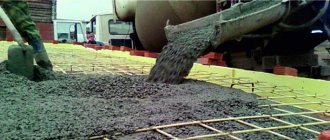Technical characteristics of concrete M400
The main characteristics of the material are regulated by GOST 31108-2003 “General construction cements”, GOST 7473-2010 “Concrete mixtures” and a number of other regulatory documents.
Important technical parameters that the concrete solution must meet:
- Mobility (workability) - P4. Concrete can be poured into reinforced structures without additional compaction, which is effective when constructing foundations and columns. If necessary, by introducing additives and changing proportions, it is possible to obtain M400 concrete with mobility P3 or P5.
- Water resistance - W6–W12. Finished structures made from this solution can withstand liquid pressure of 0.6-1.2 MPa. Concrete can be used for underwater structures - dams, swimming pools.
- Frost resistance - F100-F300. Concrete can withstand from 100 to 300 cycles of freezing and thawing (the exact figure depends on the type and number of special modifiers). Due to such high frost resistance, the solution is used for buildings in harsh climates.
- The density of M400 concrete is more than 2400 kg/m³, compressive strength is 400 kgf/cm². These indicators make the material very reliable, wear-resistant and durable.
Concrete M400 has excellent characteristics, therefore it is suitable for the construction of most buildings, structures and structures in everyday life and industry. It sets faster than other brands, and this property makes it possible to speed up construction work.
Important! After hardening, the solution turns into an indestructible monolith, which is practically unaffected by natural factors.
Composition and proportions of components
The material contains standard ingredients: river or quarry sand, cement, gravel or crushed stone. The finished mixture is diluted with clean water without chemical impurities.
To improve technical parameters, plasticizers and other additives are also necessarily introduced into the composition. To make colored concrete, colors can be added to it.
Concrete M400 on crushed stone
When mixing the material with your own hands or in industry, use the following proportions:
- cement – 1 part;
- sand – 1.5 parts;
- crushed stone - 2.5 parts;
- water – 0.5 parts.
Advice! If a construction project requires a large amount of mortar, it would be more expedient to buy it ready-made at the factory and deliver it to the construction site by special transport.
Knowledge helps you save on construction
Knowing how many cubes of concrete are in the KAMAZ mixer, you can order enough mortar to fill the foundation. Manufacturers make drums designed to transport from 2 to 12 cubic meters of concrete at a time. The most popular orders are for 5, 7, 9 cubic meters of ready-made solution. In addition to transporting and preserving the commercial qualities of the finished mixture, these concrete mixers are capable of pouring prepared structures during unloading.
Read also: How to run wires into a panel
Concrete strength classes m400
The strength class of a mortar is understood as a numerical parameter that determines its compressive strength. It is calculated in megapascals and is designated by the letter “B”.
Concrete grade M400 corresponds to strength class 30 (B30). This means that concrete can withstand a pressure of 30 megapascals after complete hardening in at least 95% of cases. This figure is considered very high, so the material belongs to the structural group and is suitable for the construction of high-rise buildings.
Application of M400 concrete
The material is used for the construction of objects, during the operation of which significant mechanical loads arise, which contribute to strong stress on the monolith. The following structures are built from M400 concrete:
- bridges on highways, railways;
- overpasses for transport and overpasses, viaducts;
- bank vaults, ammunition and weapons warehouses, military buildings;
- columns, lintels, beams;
- hydraulic structures - dams, dams, breakwaters, swimming pools, hydroelectric power stations;
- monolithic high-rise buildings;
- collectors for communications;
- any objects requiring high security;
- stairs and flights of stairs;
- buildings in the energy, engineering, ore mining sectors;
- sewer tunnels;
- foundations of multi-story buildings;
- metro facilities.
Concrete is suitable for pouring durable reinforced concrete structures that will endure the most severe loads. In this case, granite filler is introduced into its composition instead of crushed stone.
Preparation of concrete
In order for a solution made at home to fully meet the requirements, you will have to obtain only the highest quality components for mixing it. It is also important to accurately observe the proportions and manufacturing technology of M400 concrete.
The sand must be clean, without impurities of soil, clay, lime, which increase the viscosity and interfere with the adhesion of the solution. In addition, if dirty sand is used, the strength of the concrete will decrease.
Advice! The ideal option is not to collect sand yourself, but to buy it in a hardware store in an already purified form.
As a last resort, quarry or river sand will do, but only well washed and dried. Before mixing concrete, wet sand is dried or the amount of water in the solution is reduced. The liquid should also be clean, completely free of chemical impurities and slightly warm (not hot).
The crushed stone for concrete is not large, but not small either, approximately within the range of 5-20 mm (size of individual elements). It is better to take only high-quality types of crushed stone with a strength index of M1100 or more, which are produced by crushing the hardest rocks.
The requirements for cement are the most stringent:
- grade - no lower than ready-made concrete (otherwise the solution will have a low specific gravity);
- fine-grained variety;
- absence of excessive moisture, lumps;
- storage - only in the right conditions and no more than 3 months from the date of production.
After selecting the components, they begin to weigh them. First, combine cement and sand, mix the mass thoroughly in a concrete mixer until it becomes homogeneous.
Afterwards, a liquid with dissolved plasticizers is introduced, which was strictly adjusted in volume in advance. The strength and frost resistance of concrete depend on strict adherence to water standards. The last thing to do is add crushed stone and mix the solution again, which should resemble thick sour cream in texture.
When ready, the concrete is transported to the site and pouring begins. To prevent the material from hardening too quickly, or from slowing down the hardening process, it is important to work at positive temperatures, but not in extreme heat.
Advice! In addition to independently selecting the components and calculating the proportions, you can go the other way - buy ready-made dry mixture in bags and dilute it with water.
Main components of the solution
It is no secret that the quality of the building material and the service life of the building that will be erected directly depend not only on the correctly selected proportions, but also on the choice of key components. Before starting work, it is necessary to carefully consider the composition of a particular brand of concrete, its properties and features of the components.
As you know, concrete solutions are created from the following parts:
The main element of every concrete mixture is cement. The duration of hardening of the final product and the strength of the future building depend on the quality of this component. There is a wide variety of binding elements of different series and properties on sale. Among them, Portland cement is very popular, which guarantees better adhesion of substances and strength of the product.
On each package of cement the brand is indicated with the symbol “M”, as well as the measurement coefficient in the form of kg/cm3. The strength characteristics of the material depend on this designation. For example, the proportions of M300 concrete in buckets differ significantly from the proportions for grades M400, M100, M150, M200, etc.
When choosing a suitable brand, it is important to understand in advance the main characteristics of the series and consult with a specialist. Depending on the individuality of the project, the grade and proportions of concrete may differ.
The next element in concrete mortar is sand. It plays an astringent role and is provided for in the cooking design. Experienced builders advise taking purified quartz or river sand with a small fraction - 1.2-3.5 millimeters. It is important to make sure that the component is completely clean and does not contain clay impurities. Otherwise, the strength factor will be seriously affected. Before you start mixing, the sand must be sifted through a sieve with small cells, which will prevent the entry of foreign inclusions.
Crushed stone and water
Also, the concrete mixture must contain coarse filler. We are talking about crushed stone, which gives the consistency maximum strength and reliability. When constructing household structures, the optimal solution is grains with a diameter of 10-20 centimeters. If the cells are larger, they will be indispensable for industrial areas.
The presence of water in the mixture is provided for in individual construction projects. The liquid used must be absolutely clean and not contain any chemical or oily additives.
To mix concrete in a concrete mixer for domestic purposes, it is better to use rain or settled water. If the scale of construction is industrial, a purified option is quite suitable.
If it is necessary to build a load-bearing wall structure, it is better to prepare cement under the brands M400, M300, M500. For arranging partition structures, brand 300 will do just fine. If we are talking about a building with small dimensions, then it is better to opt for the M200 model.
To equip a high-quality foundation for the convenient construction of a future premises, it is better to take the M200 brand. If the roofing structure is provided for by the project, the concrete must be more durable and correspond to the M400−500 series.
Blind area and plaster
As for the blind area, it will be of truly high quality if you use M50-M150 grade cement. As you know, such structures do not have to cope with heavy loads, so those series of cement mixtures that do not have high strength are quite suitable for their construction. However, if you need to build a floor, it is better to give preference to more durable products that will meet the requirements of the floor covering.
Read also: DIY iron products
Another important element of the mixture is plaster. In order for the material to show its best side, it is better to include cement mixtures under the M300−400 brands.
There is no point in buying large volumes of concrete if it will not be used up within 30 days. The fact is that after 30 days the building material will lose a lot of its performance properties and will not be able to provide the required quality of construction. In just two months the loss will reach -10%, after six months - -50%, and after a year the cement will generally become unsuitable for use.
The main disadvantage of the cement mixture is its lumpy nature. This problem is typical for cheap brands from dubious manufacturers. To avoid trouble, it is better not to save money by buying unmarked, old or discounted cement.
Example of calculation in buckets per 1 cubic meter
At home, it is most convenient to measure components using a standard 10-liter bucket, which any builder has. Each liter of volume in a bucket is equal to 1 dm³, that is, the entire volume will be 0.01 m³ (10 dm³).
To obtain concrete, in addition to 300 liters (30 buckets) of cement, the following components are taken:
- Sand with a density of 1600 kg/m³. There are 1.6 kg of sand per liter. For a norm of 630 kg, the volume will be 394 kg, the number of buckets will be 39.4.
- Crushed stone with a density of 1400 kg/m³. A liter contains 1.4 kg. For a norm of 1050 kg, the volume is 750 liters, that is, 75 buckets.
- Water. In total you need 210 liters of water, or 21 buckets.
Knowledge of the specified standards and proportions will allow you to determine the number of components that will be required to fill the structure, as well as the approximate costs.
Calculation of concrete proportions
When calculating the proportions of concrete, it is necessary to take into account many factors, for example, the fractions of sand and crushed stone, their density, the required qualities of the future concrete, namely frost resistance, water resistance, mobility and others.
The table of concrete proportions shows average data. The relationships between materials are usually established by weight or volume. In this case, the weight (volume) of cement is taken as a unit, and the amount of other components of concrete is expressed in terms of the weight or volume of cement.
For example, if a batch requires 25 kg of cement (C), 75 kg of sand (P), 125 kg of crushed stone (SH), then their ratio for the composition will be expressed as follows: 25:75:125 = 1:3:5 (by weight). The amount of water is usually expressed in parts of the weight of the cement. If the given concrete composition requires 12.5 liters of water, then the water-cement ratio (W/C) will look like this: W/C = 12.5:25 = 0.5. The strength of concrete increases as a result of the interaction of cement with water, which normally occurs in warm and humid conditions.
The interaction of cement with water stops if the concrete dries out or freezes ahead of time, which irreparably deteriorates its structure and properties. Therefore, concrete needs care to create normal hardening conditions, especially in the initial period after laying (up to 15-28 days).
The relationship between the class and grades of concrete in terms of strength
In the warm season, moisture in concrete is retained by watering and covering. A bitumen emulsion is applied to the surface of freshly laid concrete or it is covered with polyethylene and other films. Concrete under normal hardening conditions has low initial strength and only after 7 - 14 days acquires 60-80% of its brand strength.
Concrete from (c) cement M-400, (p) sand and (s) crushed stone
Concrete from (c) cement M-400, (p) sand and (s) crushed stone
Example of calculation in a concrete mixer
The standard tank volume of a concrete mixer is 140 liters. Usually it is loaded no more than 2/3 full to allow the components to mix better.
Thus, the loading rate will be 140x2/3 = 93 liters. When combining the coefficients in proportion, the figure is 5.5 (1 part cement + 1.5 parts sand + 2.5 parts crushed stone + 0.5 parts water). By multiplying by 10 liters (the volume of the bucket), 55 liters are obtained, and when dividing 93 l/55 l, the number of loads is calculated - 1.69 pieces.
When multiplied by 1.69 by the proportions, the following standards are obtained for one load into a concrete mixer:
- cement – 16.9 l;
- sand – 25.3 l;
- crushed stone - 42.3 l;
- water – 8.5 l.
Mixture composition
The composition of any concrete includes components such as sand, crushed stone, cement and water. Different brands differ only in their proportions. Sometimes plasticizers and other substances are also mixed into it, increasing the ease of working with building materials and its other parameters. The M400 grade mixture should contain 1.5 parts sand, 2.5 crushed stone and 0.5 water per part of cement. However, the specific gravity of all these substances is different, which can complicate calculations, especially at home.
READ Characteristics and scope of concrete grade M450
One cubic meter of M400 concrete weighs approximately 2315 kg. This means that for its manufacture you will need the following amount of material:
- 1085 kg of crushed stone. Considering its specific strength of 1350 kg/m³, 1 liter of the substance will weigh 1.35 kg. That is, the required volume into which 1085 crushed stone will fit will be 1085/1.35, which is equal to 804 liters or 80.4 ordinary ten-liter buckets.
- 625 kg of sand. Its specific gravity is 1500 kg/m³, that is, one liter will have a mass of 1.5 kg. This means that to prepare a cubic meter of cement you need 625/1.5 = 416.6 liters of sand or 41.66 household buckets.
- 420 kg of cement. The specific gravity is 1300, and the mass of one liter is 1.3 kg. To prepare the mixture you will need 420/1.3=323 liters or 32.3 buckets.
- 190 liters of water. The specific gravity is approximately 1 kg per liter, that is, 19 buckets are required.
When measuring proportions in this way, do not forget to constantly shake off the “caps” of sand and gravel from the buckets - they can significantly increase their weight and throw off the proportions.
Otherwise, this calculation method is optimal for calculating the proportions of ingredients for private builders who do not have special equipment.
